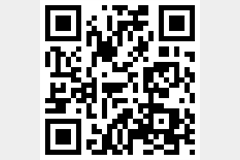
For an 18 year old innovation, QR (quick response) codes are getting a lot of media attention. This week Kishen and I were asked to author a half hour CPD film on them and I have also been busy engaging with business owners interested in QR on a variety of forums.
A QR code is a type of barcode, in essence not dissimilar to that which you will find on a box of cornflakes.
The QR stands for Quick Response and they were invented way back in 1994 by a subsidiary of Toyota, making it about the same age as the commercial internet itself.
Developing the QR code was originally to fulfill an industrial purpose where the codes themselves could contain more information and would be faster to read or scan than a traditional bar code. The codes would be used for tracking car parts for logistic, storage, stock and ordering processes. Scanned on the factory floor, there was a need for workers to have more information about the part and also to be able to scan them very quickly.
Aside for the quirky looks, a structured matrix of usually black and white squares, the QR code is growing in popularity because of its high data capacity of 4,296 alphanumeric characters and because of its very effective error correcting algorithm which enables more reliable and quicker scanning.
The prevalence of smartphones over the last few years has given a new lease of life to QR codes, pulling it out of the factory floor and into the sexy realm of marketing and corporate communications. Most smartphones can be quickly and easily adapted to read QR codes and download information that may have been stored on the code.
The QR reader automates certain functions within the device, depending on the requirements of the data in the code. On scanning the phone can then automatically:
– Open web pages in your mobile web browser
– Start a live-stream of video or audio
– Add contact details to your address book for later use
– Open a location on a map
QR Code adoption 10 to 20% is still fairly low but the rate at which people are discovering them and using them is astronomical, about four and a half thousand % year on year. With smartphones becoming cheaper and more pervasive, that is expected to continue to increase. The jury is still out on whether QR Codes are here to stay, but most agree that they cannot be ignored right now.
Studies have found that earlier adopters of the technology have been young adults, a fact that has not gone unnoticed by marketers. QR codes are finding their way onto all forms of printed material to attract the interest of this commercially attractive audience. This is an application that could be adopted by the insurance industry when trying to engage with this mobile and online demographic.
To date, most new use cases for QR Codes have been in the realm of marketing and promotions – particularly for consumer led businesses. The technology naturally lends itself to this application:
It has a novelty factor which captures a curious audience who may pay more attention to a brand so they can find out what’s behind the code And It provides easy access to more engaging content, directly from traditional printed media. Crucially this engagement helps a brand keep a consumer’s attention for longer.
However, it is equally important to understand the limitations of the technology
Most readily, they will be used to contain links, so in order for the QR Code to be useful, the destination needs to be appropriately designed.
In a marketing application, linking to your corporate home page may not be as useful as linking to a short streaming video presentation. It is also important to consider mobile compatibility. iPhones for instance do not support Flash animation. A phone also has a small screen and a narrow profile so the content should be suitably scaled.
Mobile network coverage can also interfere with the function of QR codes. If a poster or banner has a QR code linked to a website but is in an area or poor mobile cover, the QR will be useless and rather hinder the campaign. For this reason, mass campaigns should view QR codes as supplementary rather than the leading technology.